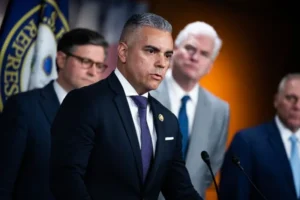The Republican Party have reached the 218-seat threshold to win control of the US House of Representatives.
The win creates a Republican trifecta that will make it easier for President-elect Donald Trump to enact his agenda.
The Senate, or upper chamber, and the White House had already flipped to Republicans – meaning the new president-elect will now have significant power after he is sworn in on 20 January 2025.
The exact margin – likely to be slim – of a Republican lead in the House remains up in the air as several races have yet to be called.
Republicans will now have full control of Washington even if it is by narrow margins.
This will give the party the ability to initiate spending legislation and launch impeachment proceedings against officials.
Under Trump, a unified Republican Party could more easily push through tax cuts and introduce border control measures.
The win for Republicans comes one week after Election Day after Republican Juan Ciscomani defeated his Democratic challenger in Arizona’s 6th district.
Republicans defended several seats in states like California and Arizona while also defeating Democratic incumbents in battleground districts.
The party gained control of the House in the 2022 midterm elections and this win came despite a year of political party in-fighting capped off by chaotic speakership elections.
But for House Speaker Mike Johnson, who won the party nomination on Wednesday to keep his job, there’s a possibility Republican numbers in the lower chamber may shrink.
Trump has tapped several Republican House members in the last week to nominate to his cabinet, posing a potential threat to the party’s lead.

Trump’s nominations – if confirmed through the Senate – will lead to several special elections and appointments by governors to fill the vacant seats.
For Senate seats, governors appoint replacements who serve until the next election.
The incoming vice-president, JD Vance, and Trump’s pick for Secretary of State, Florida Senator Marco Rubio, will have seats filled by their respective state’s governors.
In the House, vacancies are exclusively filled by special elections – a process that often takes months to complete.
Trump’s pick for United Nations ambassador, New York Congresswoman Elise Stefanik, will prompt a special election in New York’s 21st congressional district.
Congressman Michael Waltz, who Trump appointed to serve as his National Security adviser, will also see his seat in Florida’s 6th district filled by a special election.
Both seats are solidly red and will likely remain Republican.
Florida Congressman Matt Gaetz resigned from his seat on Wednesday after Trump nominated him to serve as attorney general, creating another House vacancy that will need to be filled.
Margins could still fluctuate as outstanding House races are called. Here are several that we’re still watching:
- Alaska at-large: Republican Nick Begich currently leads incumbent Democrat Mary Peltola, but the race has yet to be called.
- California’s 9th: Republican Kevin Lincoln is challenging Democratic incumbent Josh Harder, who has a slight lead.
- California’s 13th: Incumbent Republican Congressman John Duarte is running against Democrat Adam Gray. Duarte has been leading.
- California’s 21st: Republican Michael Maher is challenging Democratic incumbent Jim Costa. Costa leads by a small margin.
- California’s 45th: Republican Congresswoman Michelle Steel, the incumbent, has been leading against Democrat Derek Tran.
- Iowa’s 1st: Republican Mariannette Miller-Meeks is leading against Democrat challenger Christina Bohannan.
- Maine’s 2nd: Incumbent Democratic Congressman Jared Golden is fighting to keep his seat against Republican challenger Austin Theriault. Golden is currently leading.
- Ohio’s 9th: Incumbent Democratic Congresswoman Marcy Kaptur, who has served in Congress since 1983, narrowly leads in the race against her Republican challenger Derek Merrin.
- Oregon’s 5th: Democratic challenger Janelle Bynum faces off against Republican incumbent Lori Chavez-DeRemer. Bynum is currently leading. BBC


